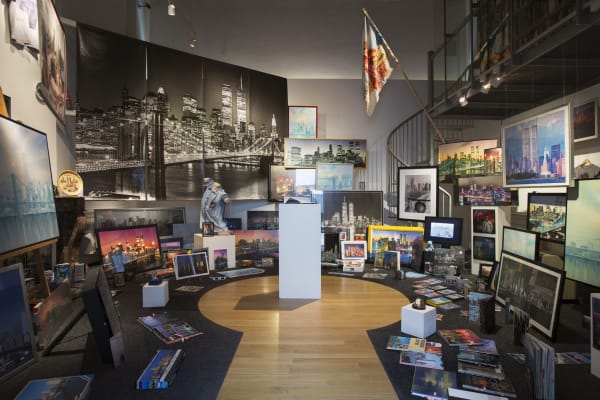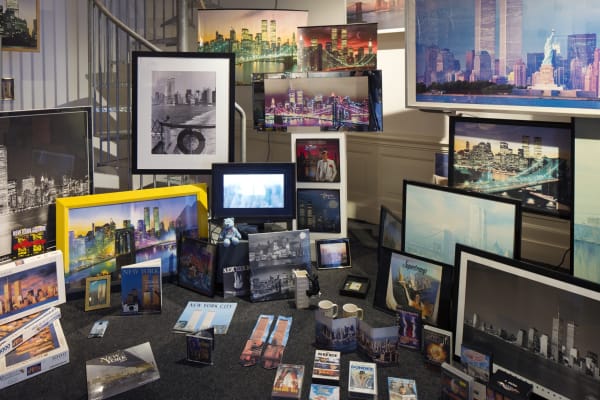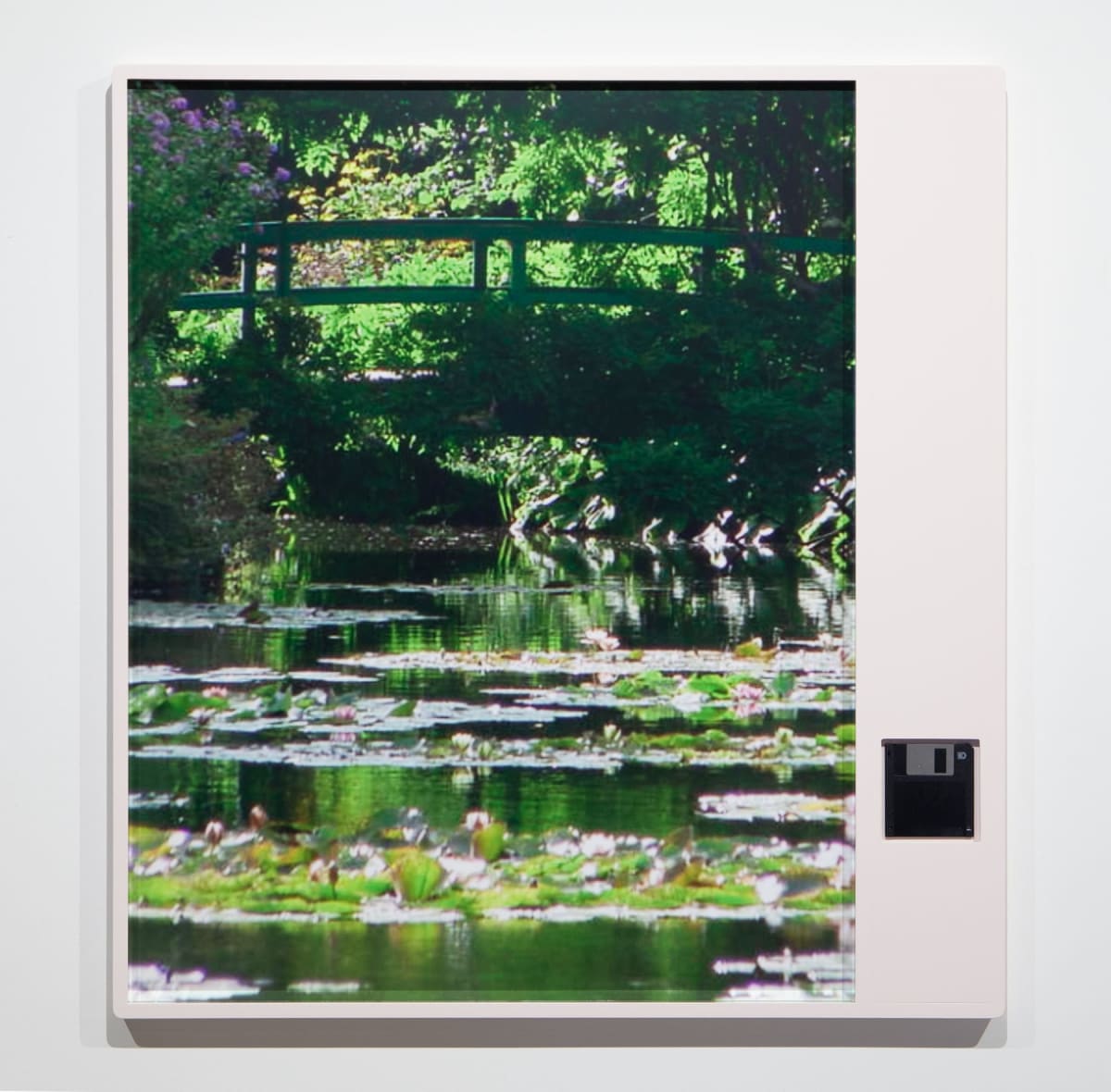FOAM | 'When the Twins were still beautiful': Thomas Kuijpers
It all started with a painting by an unknown artist depicting the iconic image of the Twin Towers. The description only said ‘painted before 2001’. When visual artist Thomas Kuijpers looked at it for the first time, the replaying footage of the collapsing towers so heavily engrained in his memory was put on hold for a moment, and replaced by a glimpse of how the image of the World Trade Center must have been experienced before the disaster. Fascinated by this thought, he decided to buy the painting. This ultimately became the starting point for Kuijpers to amass a wide collection of pre-9/11 memorabilia, including tourist photos, puzzles, socks, books, film excerpts, wallpaper and even a bathing suit.
In fact, Thomas Kuijpers artistic practice is all about collecting. Browsing the media landscape, he saves every topic of interest that might become relevant in a neat file cabinet in his studio. He has a nose for inconsistencies in media narratives and their imagery that are mostly overlooked by others. Following certain topics or media hypes for longer periods through a strict self-imposed regime of reading several daily newspapers and other media broadcasts, Kuijpers’ artistic practice is all about the development, impact, and consequences of imaging and representation. While most of his works reflect on recent happenings or developments, such as the current islamophobia in European media, the work presented in Foam 3h When the Twins were still beautiful (2013 – ongoing) harks back to longer ago and in fact reflects on a history of symbolic representation.
One of the objects in Thomas Kuijpers’ Twin Towers-collection is a postcard from 1972 with birthday wishes to Dirk, sent from New York to Holland. It is shown on the back of this booklet, and it depicts the Twin Towers as though completed, while in fact the South Tower (2 WTC) was still under construction. Although it is one of the first examples of the Twin Towers’ status as a symbol of New York in popular culture, it stems from a time of fiscal and social crises in the 1970s in which the Towers’ grandeur clashed with their social surroundings. As the backdrop against which CNN reporters presented updates on the global financial market, the WTC’s symbolism of economic power also had an unattractive aura of arrogance within New York’s rising socio-economic inequality from the 1970s to the 1990s.
Yet the more positive symbolic connotations exceeded the Twin Towers’ symbolism of economic might. The WTC was used in popular culture to symbolize “New Yorkness”. As Thomas Kuijpers’ collected footage that flickers through the installation of When the Twins were still beautiful exemplifies: a movie or series set in New York wouldn’t appear without a shot of the city’s iconic skyline with the Twin Towers shimmering in the sun, or twinkling against the night sky.
For that very reason many producers of television shows such as Friends, Spin City and Sex and the City faced an odd dilemma when the immediate crisis of September 11 took place. The two hijacked Boeing 767s that collided into the World Trade Center not only brought physical destruction; it destroyed the shows’ symbolic backdrops that signified ‘being’ in New York. Yet little had changed in the Manhattan of post-9/11 episodes of Friends: no references were made to the event but the change of New York’s skyline, making the happening present in its very absence. Sex and the City had just finished editing its fourth season, but its executive producer decided to erase the Towers from all six episodes, including from the credits, where they were superimposed with Sarah Jessica Parker’s name – the star of the show. One image was kept however: a shot of a souvenir snow globe containing replicas of the Towers, which featured in that season’s second episode.
Thomas Kuijpers’ installation When the Twins were still beautiful contains snow globes like the one from Sex and the City, and many other pre-9/11 objects that are not kitsch tourist souvenirs alone, but in retrospect have become rather nostalgic artifacts of a New York City that does not exist anymore. Yet Kuijpers’ collection bears a plurality of implications. In a way, it might remind of another TV series called Fringe, which has used the powerful image of the Towers in a unique way - to represent an alternate universe in which they still exist. At first sight, the artist equally attempts to recreate a world in which the Twin Towers are still standing, as a modern-day Don Quixote. However, his seemingly naïve creation of an alternate universe in fact refers to another paradigm, a way of seeing the world before a War on Terror emerged, prison camp Guantanamo Bay opened and a strong feeling of islamophobia spread throughout the western world. Thomas Kuijpers doesn’t provide answers, but raises questions about what 9/11 as the biggest media event in history represents in our collective memory, and how it changed the Twin Towers’ symbolic meaning. The attacks for example completely downplayed the WTC’s negative symbolic significance and still evoke a familial sense of loss that overrules earlier feelings of socio-economic inequality. From an example of “modernist architectural inhumanity” as it had been criticized before by architectural critics, it now associates with an intense humanity as its image is linked in popular culture to the images of rescue workers and firefighters, American heroism and sacrifice.
The inventory list in this booklet captures a snapshot in time of a continuously growing collection of objects depicting the Twin Towers. Thomas Kuijpers keeps on browsing through online market places, never missing new offers through the use of notification systems that warn him every time something related to the Twins is being offered for sale on the Internet. He declares to have barely had any competition in his biddings. Glancing over this inventory list perhaps assumes we do not need the actual images anymore to recall its representation. Yet stepping into the physical inventory of When the Twins were still beautiful recreates a time and paradigm seemingly suppressed.
Thomas Kuijpers (b. 1985, Helmond, NL) studied photography at the AKV St.Joost, Breda, and is represented by LhGWR, The Hague (NL). Earlier this year he had his first solo show Paradigm #01 at B.A.D., Brussels (BE). The past few years his work appeared in several group exhibitions and has been acquired for the collection of the Stedelijk Museum Amsterdam. He currently lives in Rotterdam, but holds onto his studio in Eindhoven where his archives and collections of media material are stalled and ever growing.
Text by Mirjam Kooiman / Foam curator
















